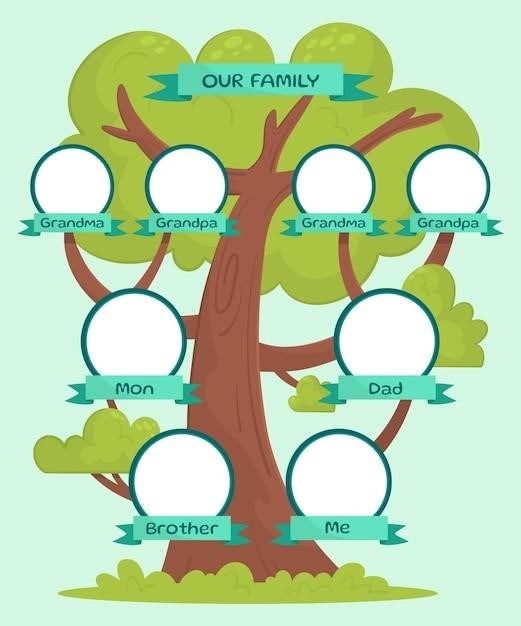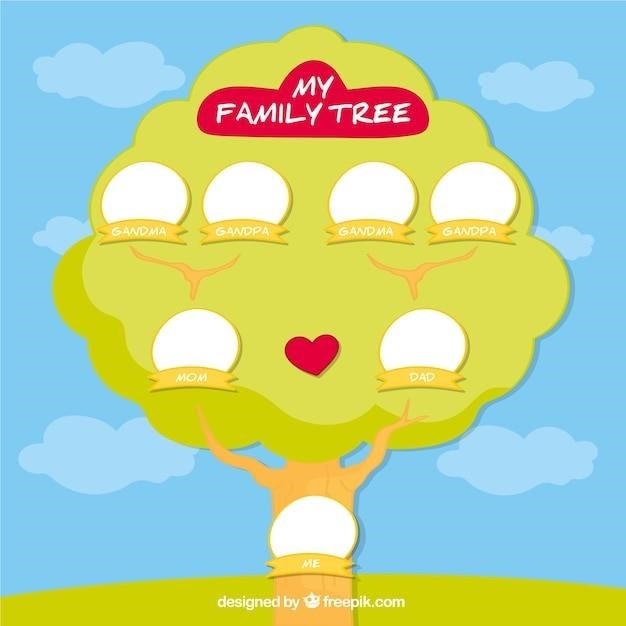Choosing a Family Tree Worksheet PDF Template
Selecting a family tree template involves considering various factors. Options range from simple charts to elaborate designs‚ accommodating diverse family sizes and structures. Free and paid templates offer different features and levels of customization. Choosing wisely ensures a user-friendly experience when documenting your family history.
Types of Family Tree Templates
The variety of family tree templates available caters to diverse needs and preferences. Simple‚ basic templates provide a straightforward structure‚ ideal for smaller families or those new to genealogy. More complex templates offer space for extensive details‚ accommodating numerous generations and branches. Some feature a traditional‚ hierarchical design‚ while others employ a fan chart or other visual arrangements for a unique presentation. Consider whether you need space for photos‚ additional notes‚ or specific relationship labels. Templates may also differ in their visual style‚ from classic and formal to modern and creative‚ reflecting personal aesthetics.
Specialized templates exist for specific purposes. Adoption templates account for unique family structures‚ while those focusing on ancestry trace lineages over many generations. Furthermore‚ some templates are designed for classroom use‚ incorporating educational elements. The choice depends on individual requirements‚ ensuring the template effectively captures and showcases your family history.
Features to Consider in a Template
When selecting a family tree template‚ several key features warrant careful consideration. The number of generations accommodated is crucial; choose a template with sufficient space for your known ancestors. Consider the inclusion of fields for vital information beyond names‚ such as birthdates‚ death dates‚ marriage dates‚ and locations. The ability to add photos significantly enhances the visual appeal and personal connection to your family history. Templates offering customization options‚ such as font styles‚ colors‚ and layouts‚ allow for personalized expression. Think about the overall aesthetic; some prefer a classic‚ formal design‚ while others might desire a more modern or creative style.
Furthermore‚ ease of use is vital. A user-friendly interface‚ intuitive navigation‚ and clear instructions are essential‚ particularly for those less familiar with genealogy software. Finally‚ the file format is important; PDF is widely compatible‚ but editable formats like Word documents provide greater flexibility for post-completion modifications. Prioritize features that align with your needs and technical capabilities for a seamless and enjoyable family history documentation process.
Free vs. Paid Templates⁚ Pros and Cons
The choice between free and paid family tree templates presents a trade-off between cost and features. Free templates offer accessibility and a wide variety of designs‚ readily available online. However‚ they may lack advanced features like extensive customization options‚ photo integration capabilities‚ or the ability to save progress and easily revert changes. Free templates may also include watermarks or branding elements. Paid templates often provide superior customization‚ more sophisticated design options‚ enhanced functionality (such as the ability to easily add photos and dates)‚ and professional aesthetics. They usually come with technical support and may offer cloud storage options for easy access and backup. The cost‚ however‚ can be a significant factor‚ especially for those on a tight budget. Consider your needs and budget before deciding; a simple‚ free template might suffice for basic family history recording‚ while a paid template provides more capabilities for extensive research and personalized presentation.

Filling Out Your Family Tree Worksheet
Accurately completing your family tree requires methodical data entry. Begin with yourself and immediate family‚ then expand generationally. Handle unknown information with placeholders or notes for future research. Accurate‚ detailed records are crucial for genealogical accuracy.
Starting with Yourself and Immediate Family
Commence your family tree construction by meticulously documenting your own details. Include your full name‚ date of birth‚ and place of birth. Next‚ focus on your immediate family⁚ parents‚ siblings‚ and spouse (if applicable). For each individual‚ record their complete names‚ birthdates‚ and places of birth. If available‚ add information such as marriage dates‚ places of marriage‚ and death dates. Ensure accuracy; verify information from multiple sources whenever possible‚ such as birth certificates‚ marriage licenses‚ and family Bibles. This foundational layer will provide a solid base for expanding your family tree into subsequent generations. Remember to use consistent formatting for names and dates to maintain clarity and organization throughout your family tree. Thoroughly documenting this initial phase will significantly enhance the accuracy and completeness of your genealogical record.
Adding Subsequent Generations
Building upon your immediate family foundation‚ systematically incorporate preceding generations. For each parent‚ add their parents (your grandparents)‚ meticulously recording names‚ birthdates‚ and places of birth. Continue this pattern for each ancestor‚ moving backward through time. If your template allows for extended family‚ include aunts‚ uncles‚ and cousins within each generation. Maintain consistency in data entry; utilize a standardized format for names and dates. Remember‚ accuracy is paramount; verify information whenever possible through official records or family testimonies. As you progress‚ consider using digital tools or online resources to assist in your research. These resources may help you locate birth certificates‚ marriage licenses‚ census records‚ or other essential genealogical documents. Each addition to your tree enriches your family’s historical narrative‚ connecting you to your ancestors and their legacies.
Handling Unknown Information
Genealogical research often encounters gaps in knowledge. When faced with missing information‚ don’t let it derail your project. Instead‚ strategically mark unknown details. Use placeholders like “Unknown” or question marks in the relevant fields. If you have partial information (e.g.‚ a possible birth year)‚ note it as such. Clearly indicate uncertainties to avoid misinterpretations. Consider creating a separate notes section or using annotations to record research efforts‚ leads‚ and potential sources. Document your attempts to find missing details‚ including dates of searches and websites visited. This approach preserves your research process and helps future generations continue the investigation. Remember‚ acknowledging the unknown is essential for maintaining the integrity of your family history documentation. Embrace the mystery and the ongoing journey of discovery that genealogy entails. This transparency enhances the overall value and credibility of your family tree.

Utilizing and Sharing Your Completed Family Tree
Once finished‚ your family tree can be saved‚ printed‚ or shared digitally. PDF format offers easy sharing and printing. Online platforms provide collaborative options and broader accessibility. Consider the best method for your needs and audience.
Saving and Printing Your Family Tree
After diligently filling out your family tree worksheet PDF‚ preserving your work is crucial. Saving your completed document as a PDF ensures its longevity and compatibility across various devices and operating systems. Most PDF editors allow for easy saving‚ typically with a “Save As” option‚ enabling you to choose a file name and location for storage; For printing‚ ensure your printer settings are optimized for the PDF’s dimensions and resolution to produce a clear‚ high-quality printout. Consider using heavier paper stock to enhance durability and prevent tearing‚ especially if you anticipate handling the printed document frequently. Adjusting the printer’s scaling settings might be necessary if the family tree doesn’t perfectly fit the paper size; you might need to print across multiple pages. Review the print preview before committing to printing to identify and correct any layout issues. Once printed‚ consider laminating your family tree for added protection against spills and wear‚ extending its lifespan and allowing for easier handling over time.
Sharing Your Family Tree Digitally
Sharing your completed family tree worksheet PDF digitally offers convenience and broad accessibility. Email is a simple method; attach the PDF to an email and send it to family members or friends. Cloud storage services like Google Drive‚ Dropbox‚ or OneDrive provide centralized storage and easy sharing options. You can upload your PDF and generate a shareable link‚ controlling access permissions as needed. For larger groups or collaborative projects‚ consider using a dedicated genealogy platform. Many platforms offer online tree-building tools‚ allowing others to contribute or view the family tree directly online. Social media platforms also offer options; however‚ prioritize privacy settings to control who can view the document. Remember to compress the PDF file size if you’re using less robust internet connections to ensure quicker download times for recipients. When sharing online‚ consider embedding the PDF in a website or blog post for easy access‚ ensuring the family history remains easily viewable for all those interested in exploring your family’s lineage.